Are Akoya Pearls The Best? A Complete Guide on Akoya Pearls

A pearl offers several benefits, such as enhancing your appearance and other crystal healing properties. Of all the various types of pearls, the Japanese Akoya pearls stand out. Known for their unique, perfectly round shape, the Japanese Akoya pearls may be the ideal item to complement your outfit or add to your jewelry collection. Continue reading to discover more about this unique gemstone.
Brief History Of Akoya pearls?
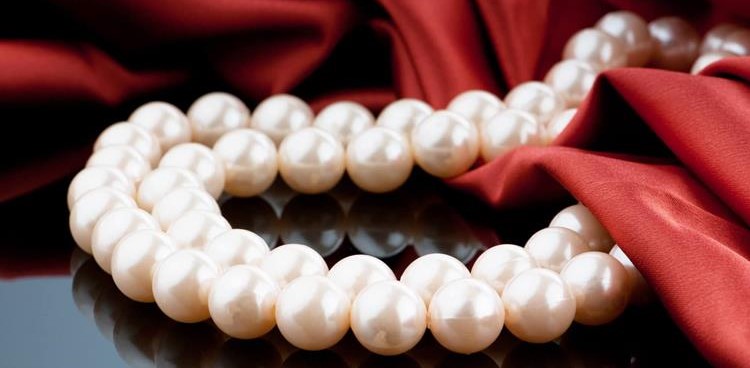
Pearls have long been a prized possession and have bewitched many a monarch. Pearls have been highly prized and guarded as a family treasure handed down from generation to generation since ancient times. They were also utilized as a payment or reward in certain regions. Wearing pearls was a privilege reserved solely for the top echelons of society in ancient Rome, and the lower classes were not permitted to hold them.

You can't begin to discuss the Akoya pearl without mentioning Kokichi Mikimoto, whose name is closely associated with the beautiful pearl. Mikimoto, the son of a Japanese noodle manufacturer, developed the world's first farmed Akoya pearl in 1893 by manually injecting an irritant into an oyster to induce it to become a pearl. The introduction of cultured pearls in the early 1900s upended the whole pearl business, causing the value of natural pearls to drop. Previously reserved for the elite classes, pearls were suddenly accessible to the general public. By 1935, Japan had 350 pearl farms producing 10 million cultivated pearls per year, and Mikimoto was continually defending himself against claims that his pearls were not "genuine."
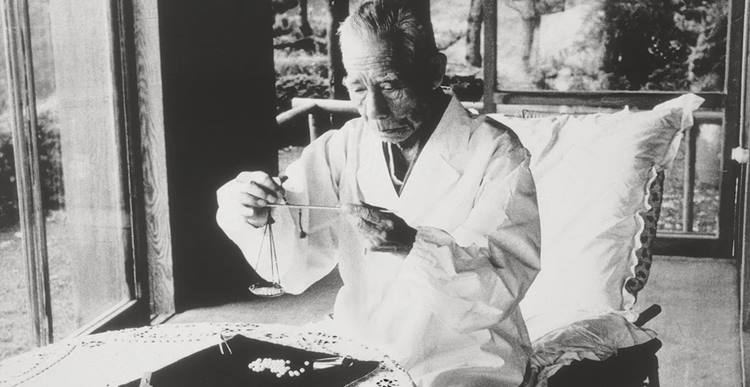
So What Are Akoya Pearls?
Akoya pearls are gorgeous seawater cultured pearls. They are produced from the uniquely shaped Akoya oyster, also known as Pinctada fucata. These rare and lovely pearls are primarily cultivated in japan. However, they have now been discovered in other regions, including Australia, China, Thailand, and Vietnam, all around the pacific ocean.

The unique and high-quality Akoya pearl, which distinguishes it from others, can be attributed to the excellent and chilly waters of the Pacific. Here's the secret: as the oyster's metabolic rate drops due to the cold waters, the nacre produced surrounding the bead nucleus becomes firmly packed in concentric layers. The tighter these layers are packed, the brighter and sharper the luster of the pearl.
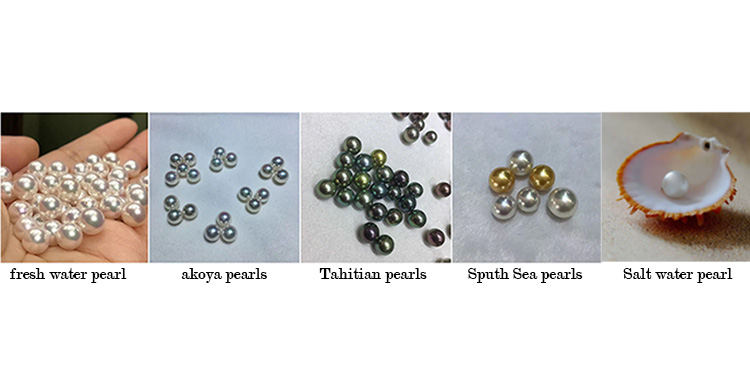
Akoya pearls are regarded as the traditional pearl used in necklaces and other pearl jewelry because of their flawless round forms, brilliant mirror-like luster, and neutral hues.
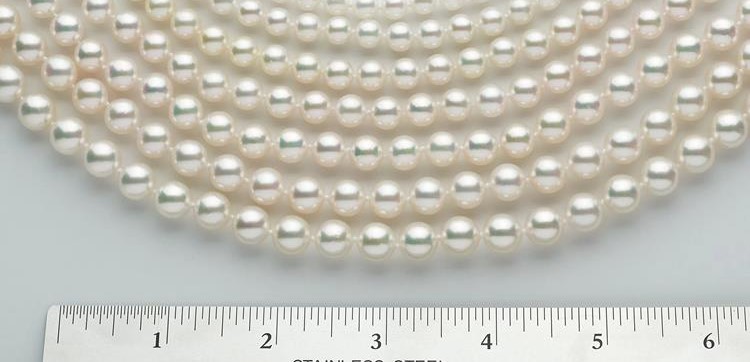
An intriguing fact about Akoya pearls is that they are the smallest commercially cultivated, pearl-producing oysters. The typical Akoya pearl is 7 mm in size, whereas the average South Sea pearl is 12 mm.
Why Are Akoya Pearls Popular?
Akoya pearls are famous for their extraordinarily superb luster and almost perfectly round shape, making them the trademark elegant pearl. Also, their delicate size and remarkable color consistency make Akoya pearls a go-to for matching necklaces and earrings.
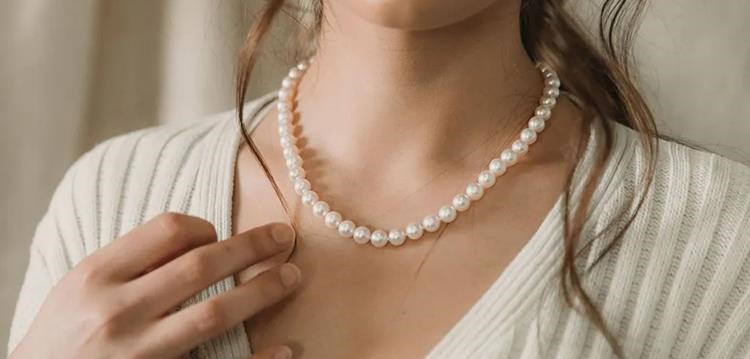
Why are Akoya pearls expensive?
Firstly, the value of pearls is determined by various factors, including how they interact with the final product. Below I will list some factors that make the Akoya pearls different and highly sought after:
Shape and size

Akoya pearls are renowned for their almost perfect round shapes and small sizes, making them more valuable due to their rarity. Akoya pearls vary from 3 to 9mm, except for a few unusual 10 - 10.5mm sizes.
Luster
Akoya pearls are incredibly lustrous, with a near-perfect metallic reflection. Since Akoya pearls come from saltwater, they stay in their oysters longer. For this reason, high-grade Akoya pearls are unparalleled in the pearl industry. That said, the higher the luster, the more valuable the pearl.
Surface quality
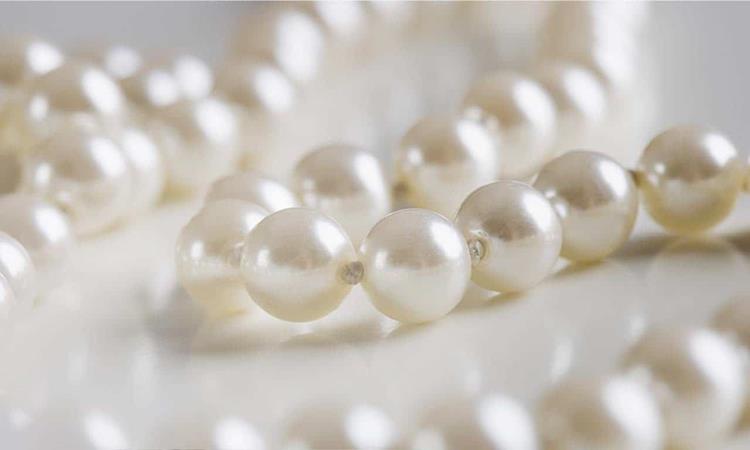
Compared to other kinds of pearls in the market, Akoya pearls have cleaner and smooth surfaces. This ensures Akoya pearls are blemish-free, allowing sunlight to reflect perfectly.
Scarcity
One of the factors contributing to Akoya pearls' expensive price tag is the relatively slow pace at which they are produced compared to their actual pearls' harvest. Only around 20% of the total crop of Japanese Akoya pearls meets the high-quality standards to be made into jewelry. Within that 20%, only about 10% meet the final requirements after expert grading.
Akoya Pearl Jewelry Value table
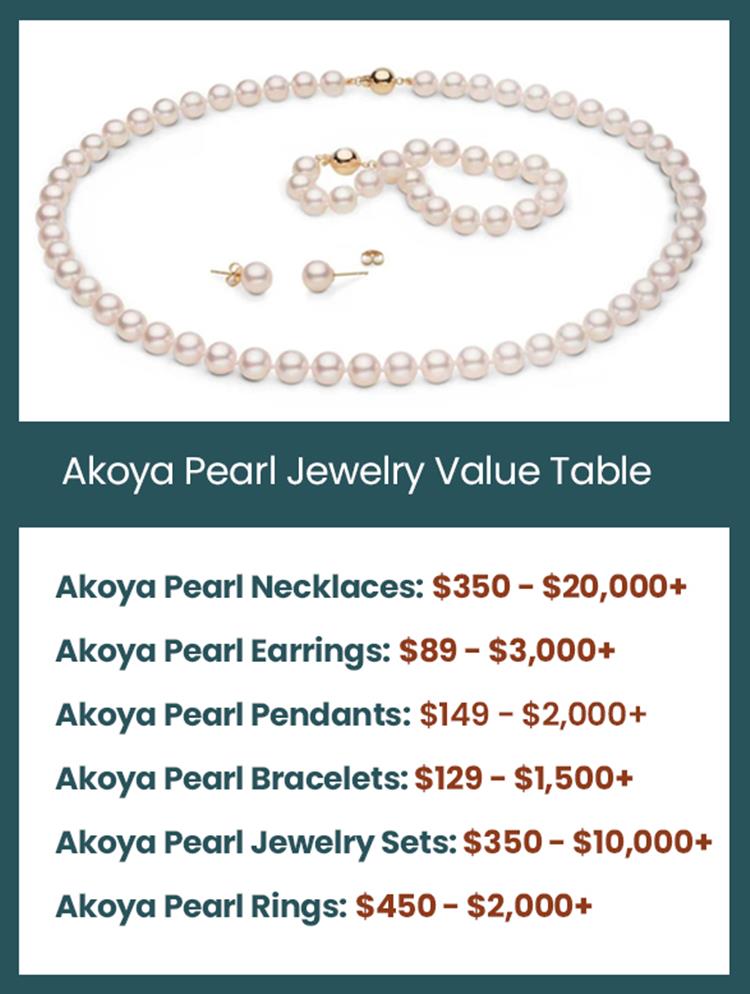
How to tell if the Akoya pearls are real?
Feeling the pearl
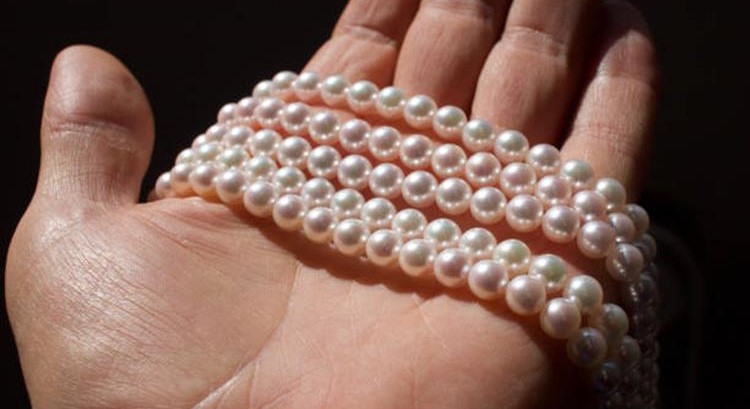
Feeling the pearl is the most straightforward way to tell a fake. Generally, genuine pearls are cold and will eventually warm up when worn. However, fake pearls always feel warmer and, most times, sticky when held.
Teeth test
Another effective way of telling if an Akoya pearl is natural is to do a teeth test. Rub the pearl on your tooth. If the pearls are genuine, it will feel a bit rough. If the pearls are counterfeit, however, they will feel very smooth.
Drill hole check

An authentic Akoya pearl will have a ring around the drilled hole. Without a drill hole, the pearl is likely to be counterfeit.
Size check
Fake pearls will always seem the same; however, genuine pearls may vary somewhat in form and size.
Weight check
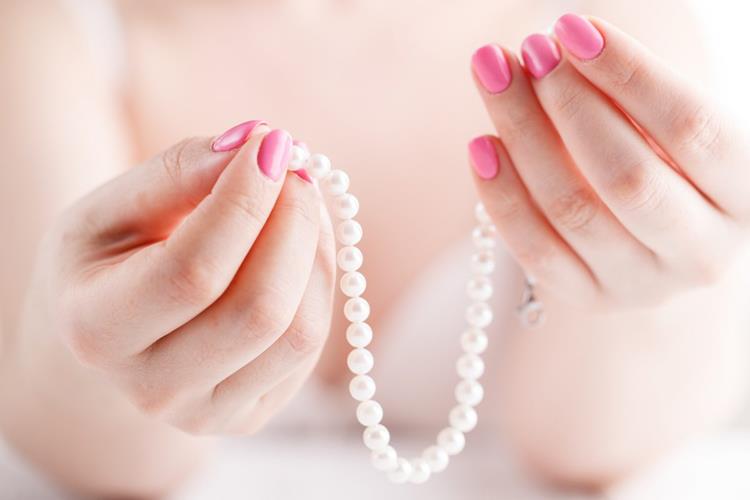
Feel the weight of the pearls in your palm. Fake pearls are often light, so you should not feel much weight in your palm. On the other hand, genuine pearls have some weight, so if they feel heavier than you thought, they are most likely genuine.
How to take care of Akoya pearls?
If treated right, Akoya pearls could last for lifetimes. Here are my top six recommendations for cleaning, storing, and caring for your Akoya pearl jewelry.
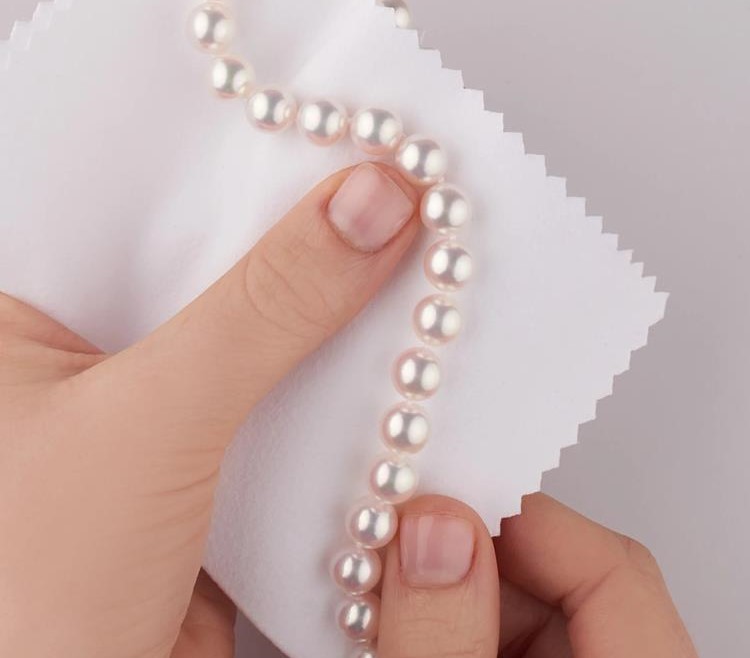
Wear your pearls as much as possible
Contrary to popular belief, wearing your pearl jewelry out and about is better than storing it in a jewelry box. They stay nourished and look good because of it (from your body oils). When pearls are kept for an extended time, they dry, become frail, and shatter. Leaving your pearl jewelry out in the open helps preserve it in excellent condition.
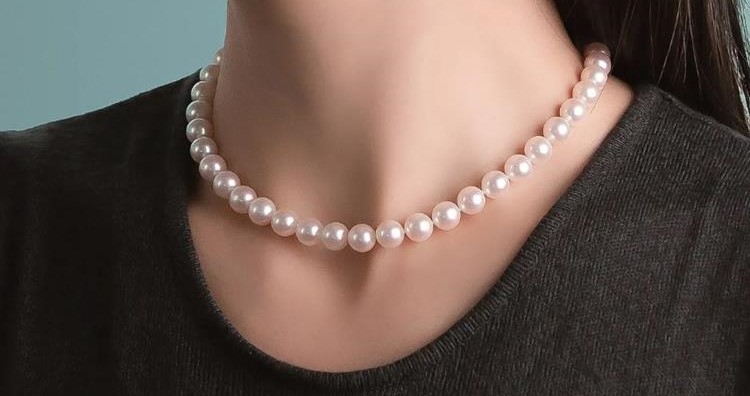
However, extreme temperatures, humidity, and direct sunshine are all very damaging to pearls. Heat and sunlight will turn your gleaming pearls brown, causing them to dry up and shatter. So remember to remove your pearl stud earrings before jumping in the shower, diving into the pool, lazing on the beach, or relaxing in the sauna.
Always wipe your pearls.
The best way to care for your pearls is to wipe them down with a moist, clean, soft cloth after each use to eliminate residues from sweat, oils, chemicals, etc.
Keep them flat

Hanging your pearl necklaces might damage the delicate silk knots that hold individual pearls in place. Pearl necklaces should be stored flat in a jewelry box to prevent the knots from becoming loose and the chain from tangled. Pearl necklaces should be restrung once every year or two to maintain the silk's integrity and the knots' security.
Don't go swimming with them.
Don't go swimming or shower in them since the chlorine in the water will dissolve the glue-binding pearl earrings, pendants, and rings to their mountings, which can cause the pearls to fall out. In other words, if you value your pearls and would rather not flush them down the toilet... There is a strict ban on both swimming and showering.
Avoid harmful chemicals

Do not use hydrogen peroxide or any other chemical bleaches or dyes to attempt to lighten your pearls. The nacre layers may be damaged or even destroyed by this.
Store your pearl jewelry separately.
Pearls are durable but may be scratched if they come in contact with something much more rigid. If you want to keep your pearl jewelry in pristine condition, it's best to keep each piece in its own dedicated space in a jewelry box. And keep your jewelry safe by avoiding keeping it in plastic bags. The chemical released by plastic bags may damage pearls. It would be best if you used a jewelry bag made of silk or suede instead.

Have trained technician care for your pearls.
Cleaning pearls is a very delicate operation. It would help if you never cleaned pearls with steam or in an ultrasonic cleaner. And only bother with home remedies like bleach and vinegar if you have a cleaning product suitable for pearls. Having your pearl necklace cleaned by an expert will ensure that it continues to shine and look its best for years to come.
What are the differences between Akoya and South sea pearls?
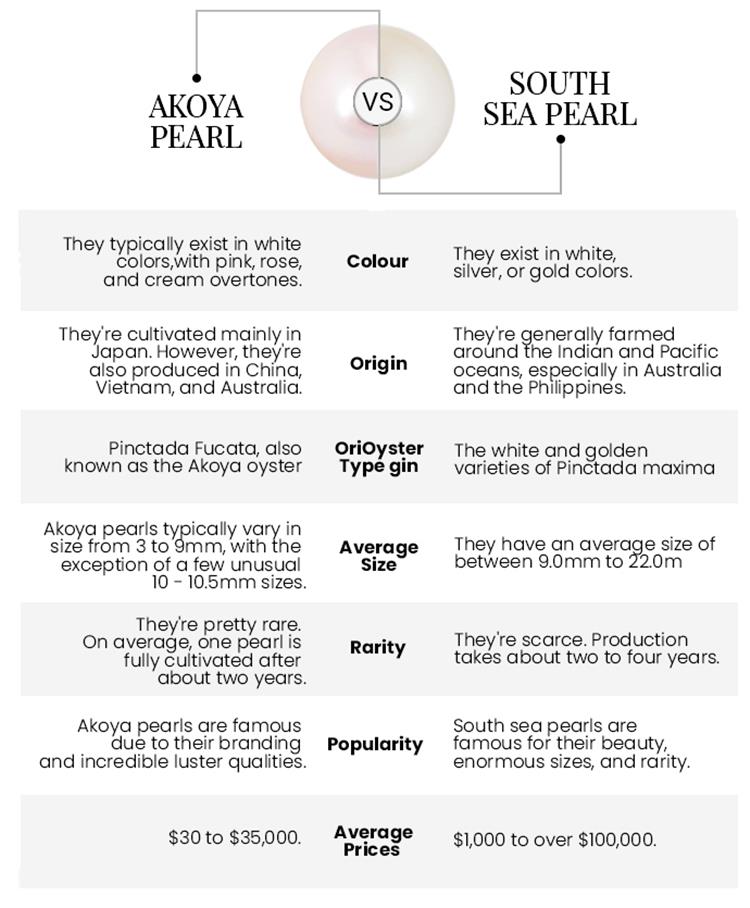
Cultured pearls come in many varieties: Akoya, Tahitian, Freshwater, White, Golden South Seas, and Sea of Cortez. The most gorgeous of them is the Akoya and South Sea Pearls, which sometimes confuse pearl buyers attempting to make a buying decision. However, represented in the table below are the key differences between both pearls:
Akoya Pearls South Sea PearlsColour
They typically exist in white colors, with pink, rose, and cream overtones.
They exist in white, silver, or gold colors.
Origin
They're cultivated mainly in Japan. However, they're also produced in China, Vietnam, and Australia.
They're generally farmed around the Indian and Pacific oceans, especially in Australia and the Philippines.

Oyster Type
Pinctada Fucata, also known as the Akoya oyster
The white and golden varieties of Pinctada maxima
Average Size
Akoya pearls typically vary from 3 to 9mm, except for a few unusual 10 - 10.5mm sizes.
They have an average size of between 9.0mm to 22.0m

Rarity
They're pretty rare. On average, one pearl is fully cultivated after about two years.They're scarce. Production takes about two to four years.
Popularity
Akoya pearls are famous due to their branding and incredible luster qualities.
South sea pearls are famous for their beauty, enormous sizes, and rarity.

Average Prices
$30 to $35,000.
$1,000 to over $100,000.


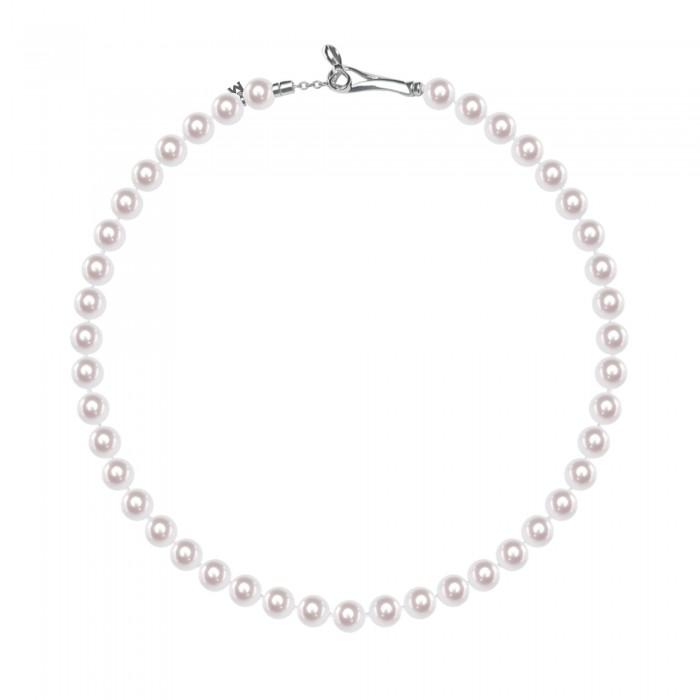
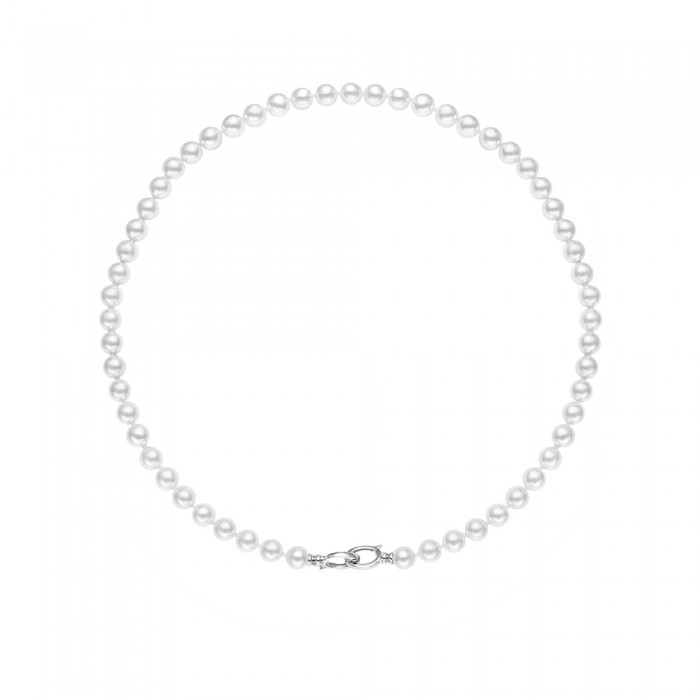
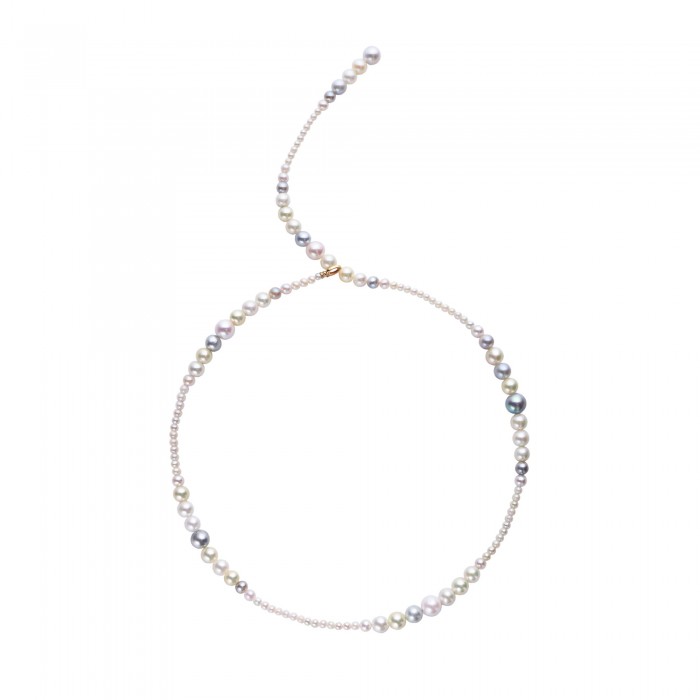
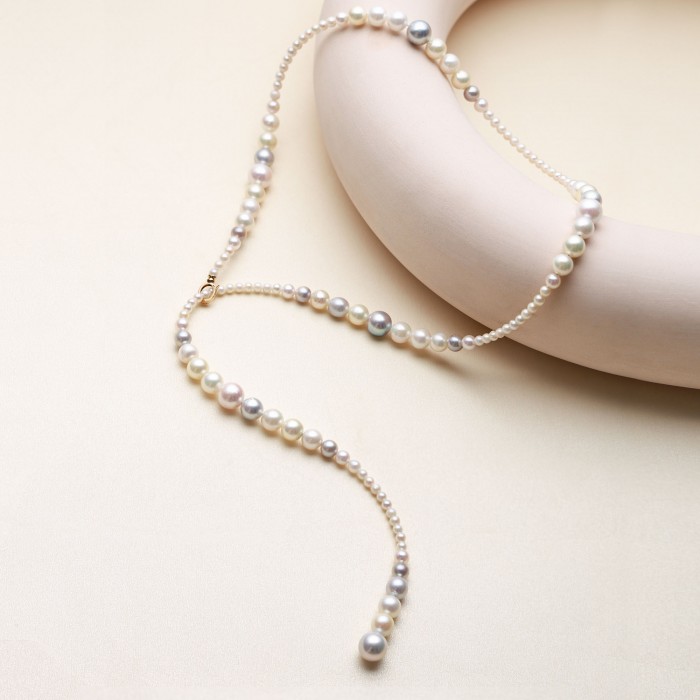
Leave a Comment